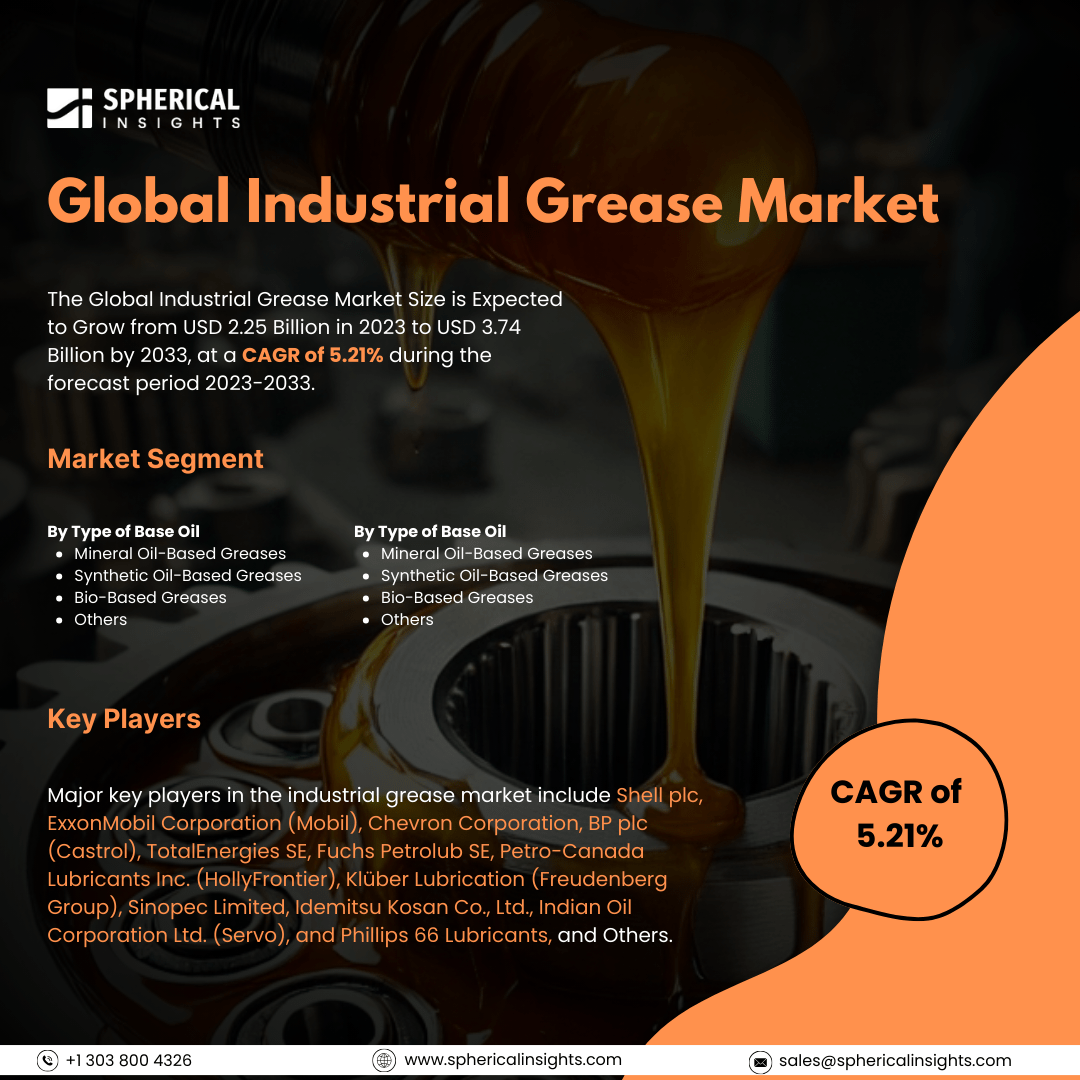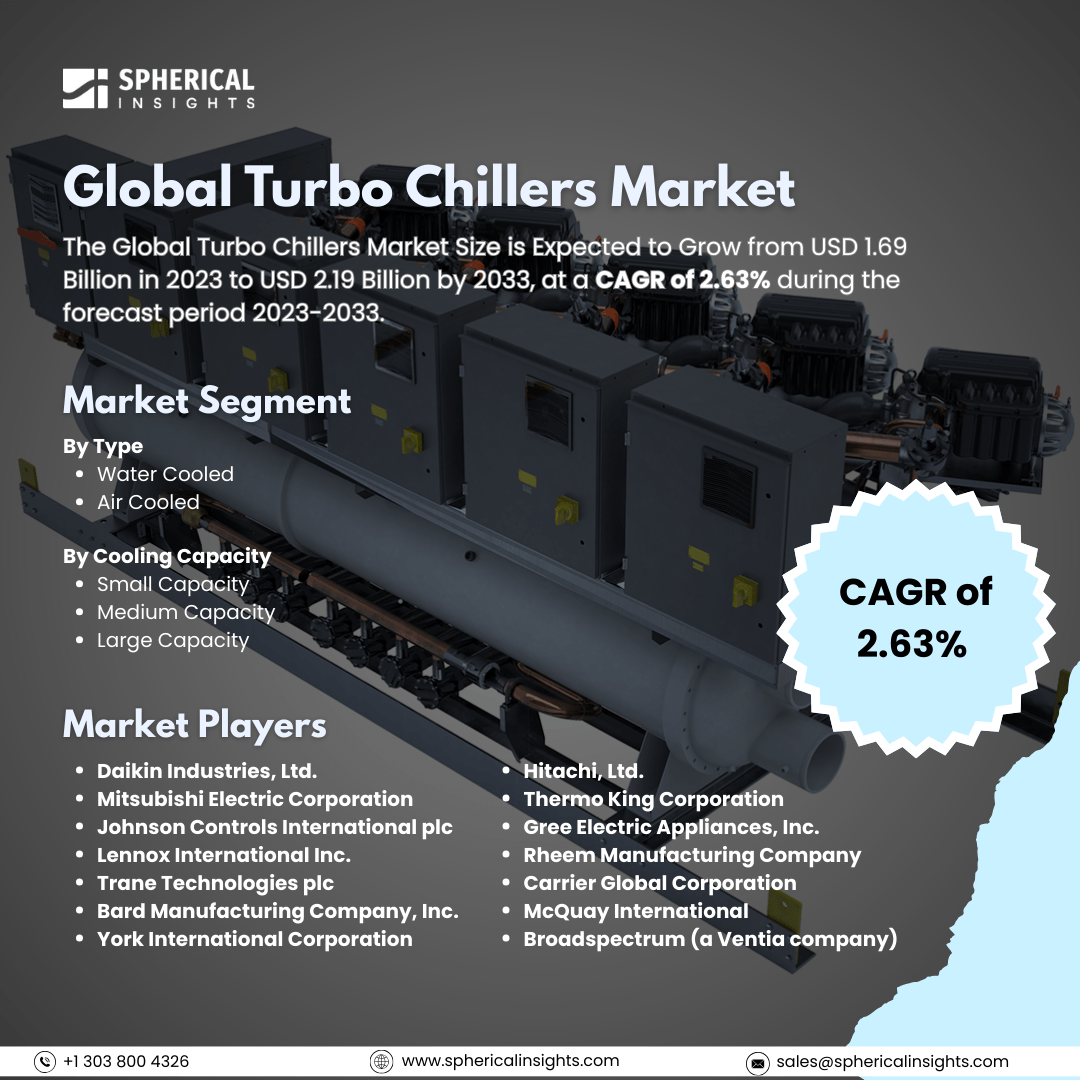Global Industrial Grease Market Size to worth USD 3.74 Billion by 2033
According to a research report published by Spherical Insights & Consulting, The Global Industrial Grease Market Size is Expected to Grow from USD 2.25 Billion in 2023 to USD 3.74 Billion by 2033, at a CAGR of 5.21% during the forecast period 2023-2033.
Browse key industry insights spread across 210 pages with 110 Market data tables and figures & charts from the report on the Global Industrial Grease Market Size, Share, and COVID-19 Impact Analysis, By Type of Base Oil (Mineral Oil-Based Greases, Synthetic Oil-Based Greases, Bio-Based Greases, and Others), By Thickener Type (Lithium-Based Greases, Calcium-Based Greases, Polyurea Greases, Complex Soap Greases, and Others), By End-User (Automotive & Transportation, Construction & Mining Equipment, Steel & Metal Processing, Food & Beverage Industry, Marine & Aerospace, and Others), and By Region (North America, Europe, Asia-Pacific, Latin America, Middle East, and Africa), Analysis and Forecast 2023 – 2033.
The industrial grease market is a worldwide industry that manufactures and distributes greases for lubricating equipment and machinery in a range of industrial settings. Usually solid or semi-solid, these greases are composed of base oils, thickeners, and additives that lessen wear, corrosion, and friction in various machinery elements, including slides, chains, bearings, and gears. The market is driven by the increasing demand for industrial machinery and equipment, rapid infrastructure development, and the need for equipment maintenance. Additionally, there is a growing preference for eco-friendly and biodegradable greases due to environmental regulations and sustainability concerns. The need for industrial greases from a range of end-use sectors is anticipated to grow as industrialization spreads throughout developing Asia Pacific, the Middle East, and Africa. Additionally, heavy-duty applications like mining and construction equipment are increasingly using sophisticated greases that can tolerate high temperatures and pressures. Globally, the industrial and construction sectors have experienced rapid expansion in the last ten years. Demand for both industries is growing as a result of the quick advancement of global industrialization. However, strict environmental laws in different places are one of the main issues the sector is dealing with. For instance, the European Union implemented directives in October 2024 to limit the concentration of dangerous chemicals in greases. Grease manufacturers are now required to register chemicals, evaluate their risks, and limit their use under the REACH regulation.
The mineral oil-based greases segment accounted for the highest share of 37.4% in 2023 and is anticipated to grow at a CAGR of 5.76% during the forecast period.
Based on the type of base oil, the industrial grease market is classified into mineral oil-based greases, synthetic oil-based greases, bio-based greases, and others. Among these, the mineral oil-based greases segment accounted for the highest share of 37.4% in 2023 and is anticipated to grow at a CAGR of 5.76% during the forecast period. The market is driven because of its reasonable price and dependable operation. Mineral base oils have historically been the most popular choice for industrial greases since they are made from crude oil. In comparison to other commodities, the cost of production and raw materials for mineral oil stays comparatively constant.
The lithium-based greases segment accounted for 17.18% of the market share in 2023 and is anticipated to grow at a CAGR of 5.36% during the forecast period.
Based on the thickener type, the industrial grease market is divided into lithium-based greases, calcium-based greases, polyurea greases, complex soap greases, and others. Among these, the lithium-based greases segment accounted for 17.18% of the market share in 2023 and is anticipated to grow at a CAGR of 5.36% during the forecast period. The improved properties of lithium complex greases have made them a popular substitute for traditional calcium and aluminum soap thickeners. They are perfect for demanding industrial applications because of their improved thermal stability, water resistance, and great load-carrying capacity.
The automotive & transportation segment accounted for the greatest share of 19.76% in 2023 and is expected to grow at a significant CAGR during the forecast period.
Based on the end-user, the industrial grease market is divided into automotive & transportation, construction & mining equipment, steel & metal processing, food & beverage industry, marine & aerospace, and others. Among these, the automotive & transportation segment accounted for the greatest share of 19.76% in 2023 and is expected to grow at a significant CAGR during the forecast period. The market is driven because of the enormous demand for transportation infrastructure. Along with investments in infrastructure improvements, this increase in vehicle traffic has increased demand for high-performance automotive materials and components, such as lubricants and specialty coatings, which are crucial for the longevity and effectiveness of vehicles.
Asia Pacific is estimated to hold the largest share of the industrial grease market over the forecast period.
Asia Pacific is estimated to hold the largest share of the industrial grease market over the forecast period. A favorable environment for this market has been established in the region by the government's strong support of industrial development and the implementation of cutting-edge lubricating technology.
Europe is predicted to have the fastest CAGR growth in the industrial grease market over the forecast period. This is because of the quick industrialization and growth of manufacturing in nations like Germany and the United Kingdom. The market for industrial greases in Europe is being driven by significant investments in industry and infrastructure developments.
Company Profiling
Major key players in the industrial grease market include Shell plc, ExxonMobil Corporation (Mobil), Chevron Corporation, BP plc (Castrol), TotalEnergies SE, Fuchs Petrolub SE, Petro-Canada Lubricants Inc. (HollyFrontier), Klüber Lubrication (Freudenberg Group), Sinopec Limited, Idemitsu Kosan Co., Ltd., Indian Oil Corporation Ltd. (Servo), and Phillips 66 Lubricants, and Others.
Recent Development
- In January 2024, the acquisition of MIDEL and MIVOLT Shell plc, formerly known as Royal Dutch Shell, a major integrated oil and gas company in the United Kingdom, was finalized by Shell Lubricants. The corporation is a major force in the energy industry, engaged in a number of operations such as the production, marketing, refining, and exploration of natural gas and oil, as well as renewable energy projects.
Key Target Audience
- Market Players
- Investors
- End-users
- Government Authorities
- Consulting And Research Firm
- Venture capitalists
- Value-Added Resellers (VARs)
Market Segment
This study forecasts revenue at global, regional, and country levels from 2023 to 2033. Spherical Insights has segmented the industrial grease market based on the below-mentioned segments:
Global Industrial Grease Market, By Type of Base Oil
- Mineral Oil-Based Greases
- Synthetic Oil-Based Greases
- Bio-Based Greases
- Others
Global Industrial Grease Market, By Thickener Type
- Lithium-Based Greases
- Calcium-Based Greases
- Polyurea Greases
- Complex Soap Greases
- Others
Global Industrial Grease Market, By End-User
- Automotive & Transportation
- Construction & Mining Equipment
- Steel & Metal Processing
- Food & Beverage Industry
- Marine & Aerospace
- Others
Global Industrial Grease Market, By Regional Analysis
- North America
- Europe
- Germany
- UK
- France
- Italy
- Spain
- Russia
- Rest of Europe
- Asia Pacific
- China
- Japan
- India
- South Korea
- Australia
- Rest of Asia Pacific
- South America
- Brazil
- Argentina
- Rest of South America
- Middle East & Africa
- UAE
- Saudi Arabia
- Qatar
- South Africa
- Rest of the Middle East & Africa



